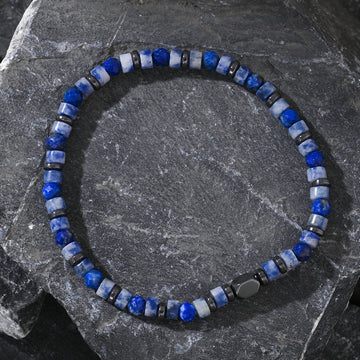Precautions for men wearing stone bracelets in daily activities
As a decorative and culturally meaningful accessory, when men wear stone bracelets, they need to take into account practicality, safety and etiquette norms. The following suggestions are provided from four aspects: wearing habits, material selection, daily maintenance, and occasion adaptation:
First, wearing habits and safety
Size adaptation
Avoid tightness: When the wrist moves, it can easily cause poor blood circulation. Wearing it for a long time may lead to swelling.
Avoid being too loose: During daily activities (such as typing and driving), it is easy to slip or collide, which may cause damage or loss of the bracelet.
Test method: It is ideal if it can be easily rotated by 1-2 finger widths after wearing.
Motion amplitude control
Avoid vigorous exercises such as basketball and boxing. Stones colliding with hard objects are prone to cracking or notches.
Reduce friction: Prolonged contact with rough surfaces (such as sandpaper, cement) may wear down the luster of the stone surface.
Environmental risk avoidance
Chemical substances: Avoid contact with corrosive liquids such as perfume, alcohol, and cleaning agents, as they may cause the stone to fade or deteriorate.
Extreme temperatures: High temperatures (such as in saunas) or low temperatures (such as in icy and snowy environments) may cause the stone to expand and contract due to temperature changes, leading to cracking.
Second, daily maintenance and care
Cleaning method
Gentle cleaning: Use a soft cloth dipped in clean water or neutral detergent to wipe gently. Do not use ultrasonic cleaners.
Drying treatment: After cleaning, let it air dry naturally or use a soft cloth to absorb the moisture to prevent moisture residue from causing cracking of the stone.
Storage method
Independent storage: Store separately in a flannel bag or jewelry box to avoid scratches with other accessories.
Moisture-proof and dust-proof: When not worn for a long time, a desiccant (such as a silica gel bag) can be placed to prevent the stone from getting damp.
Regular inspection
Observe cracks: Check the stone for any minor cracks every month and repair or replace them in a timely manner.
Metal parts: Check if the inlays or connections are loose to prevent the stone from falling off.
Third, occasion suitability and etiquette
Workplace and business occasions
Selection suggestion: A single simple obsidian or lapis lazuli bracelet, avoiding overly fancy designs.
Matching principle: When paired with a suit or shirt, the width of the bracelet should not exceed 2 centimeters, and the color should correspond to the cufflinks or tie clips.
Leisure and outdoor activities
Selection suggestions: Wear-resistant stones such as tiger's eye and agate can be paired with workwear or sporty style clothing.
Action note: It is recommended to remove the bracelet when rock climbing or cycling to prevent accidental damage.
Cultural and religious occasions
Taboo avoidance:
When participating in Buddhist activities, avoid wearing stones with auspicious meanings such as tiger teeth and Wolf teeth.
When visiting elders, choose warm and lustrous stones (such as Hetian jade) to show respect.
Fourth, handling of special circumstances
The bracelet is broken.
Emergency measures: Immediately wrap the fragments with a soft cloth to avoid scratching the skin. Contact a professional restorer for seamless bonding.
Interpretation of the meaning: In some cultures, it is believed that the breakage of stone is "warding off disasters", and the fragments can be kept as souvenirs.
Allergic reaction
Metal material: If the bracelet contains metal parts (such as silver clasps or copper cores), it may cause skin allergies. It is recommended to choose a pure stone style.
Treatment method: Apply clear nail polish to the metal contact surface, or switch to a silicone-lined bracelet.
Size adjustment
Professional adjustment: Avoid hammering or stretching by yourself. It should be left to the jewelry craftsman to adjust the size by adding or removing metal rings or adjusting knots.
Summary: When men wear stone bracelets, they need to balance practicality and aesthetics. By choosing the right material, developing proper wearing habits, and maintaining them regularly, they can not only showcase their personal charm but also extend the lifespan of the jewelry. The key lies in achieving "moderate wearing and scientific maintenance" based on one's own needs and the characteristics of the scene.







